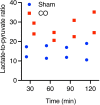Preliminary Research: Application of Non-Invasive Measure of Cytochrome c Oxidase Redox States and Mitochondrial Function in a Porcine Model of Carbon Monoxide Poisoning
- PMID: 35482181
- PMCID: PMC9198167
- DOI: 10.1007/s13181-022-00892-5
Preliminary Research: Application of Non-Invasive Measure of Cytochrome c Oxidase Redox States and Mitochondrial Function in a Porcine Model of Carbon Monoxide Poisoning
Erratum in
-
Correction to: Preliminary Research: Application of Non-Invasive Measure of Cytochrome c Oxidase Redox States and Mitochondrial Function in a Porcine Model of Carbon Monoxide Poisoning.J Med Toxicol. 2023 Jan;19(1):53. doi: 10.1007/s13181-022-00913-3. J Med Toxicol. 2023. PMID: 36508082 Free PMC article. No abstract available.
Abstract
Introduction: Carbon monoxide (CO) is a colorless and odorless gas that is a leading cause of environmental poisoning in the USA with substantial mortality and morbidity. The mechanism of CO poisoning is complex and includes hypoxia, inflammation, and leukocyte sequestration in brain microvessel segments leading to increased reactive oxygen species. Another important pathway is the effects of CO on the mitochondria, specifically at cytochrome c oxidase, also known as Complex IV (CIV). The purpose of this ongoing study is the preliminary development of a porcine model of CO poisoning for investigation of alterations in brain mitochondrial physiology.
Methods: Four pigs (10 kg) were divided into two groups: Sham (n = 2) and CO (n = 2). Administration of a dose of CO at 2000 ppm to the CO group over 120 minutes followed by 30 minutes of re-oxygenation at room air. The control group received room air for 150 minutes. Non-invasive optical monitoring was used to measure CIV redox states. Cerebral microdialysis was performed to obtain semi real-time measurements of cerebral metabolic status. At the end of the exposure, fresh brain tissue (cortical and hippocampal) was immediately harvested to measure mitochondrial respiration. Snap frozen cortical tissue was also used for ATP concentrations and western blotting.
Results: While a preliminary ongoing study, animals in the CO group showed possible early decreases in brain mitochondrial respiration, citrate synthase density, CIV redox changes measured with optics, and an increase in the lactate-to-pyruvate ratio.
Conclusions: There is a possible observable phenotype highlighting the important role of mitochondrial function in the injury of CO poisoning.
Keywords: Basic science; Biomarker; Carbon monoxide; Mitochondria; Optics.
© 2022. American College of Medical Toxicology.
Conflict of interest statement
None
Figures




Similar articles
-
Investigation of Cerebral Mitochondrial Injury in a Porcine Survivor Model of Carbon Monoxide Poisoning.J Med Toxicol. 2024 Jan;20(1):39-48. doi: 10.1007/s13181-023-00971-1. Epub 2023 Oct 17. J Med Toxicol. 2024. PMID: 37847352 Free PMC article.
-
Alterations in cerebral and cardiac mitochondrial function in a porcine model of acute carbon monoxide poisoning.Clin Toxicol (Phila). 2021 Sep;59(9):801-809. doi: 10.1080/15563650.2020.1870691. Epub 2021 Feb 2. Clin Toxicol (Phila). 2021. PMID: 33529085 Free PMC article.
-
A preliminary study in the alterations of mitochondrial respiration in patients with carbon monoxide poisoning measured in blood cells.Clin Toxicol (Phila). 2017 Jul;55(6):579-584. doi: 10.1080/15563650.2017.1288912. Epub 2017 Feb 16. Clin Toxicol (Phila). 2017. PMID: 28489460 Free PMC article.
-
Pathobiochemistry of CO poisoning.FEBS Lett. 1990 Oct 15;272(1-2):1-6. doi: 10.1016/0014-5793(90)80436-m. FEBS Lett. 1990. PMID: 2172009 Review.
-
Carbon monoxide - beyond toxicity?Toxicol Lett. 2020 Oct 15;333:251-260. doi: 10.1016/j.toxlet.2020.08.010. Epub 2020 Aug 26. Toxicol Lett. 2020. PMID: 32860873 Review.
Cited by
-
Investigation of Cerebral Mitochondrial Injury in a Porcine Survivor Model of Carbon Monoxide Poisoning.J Med Toxicol. 2024 Jan;20(1):39-48. doi: 10.1007/s13181-023-00971-1. Epub 2023 Oct 17. J Med Toxicol. 2024. PMID: 37847352 Free PMC article.
-
Attenuation of mitochondrial dysfunction in a ventricular fibrillation swine model of cardiac arrest treated with carbon monoxide.Resuscitation. 2025 Aug;213:110647. doi: 10.1016/j.resuscitation.2025.110647. Epub 2025 May 16. Resuscitation. 2025. PMID: 40383501 Free PMC article.
-
Alteration in Cerebral Metabolism in a Rodent Model of Acute Sub-lethal Cyanide Poisoning.J Med Toxicol. 2023 Apr;19(2):196-204. doi: 10.1007/s13181-022-00928-w. Epub 2023 Feb 9. J Med Toxicol. 2023. PMID: 36757579 Free PMC article.
-
Carbon monoxide as a cellular protective agent in a swine model of cardiac arrest protocol.PLoS One. 2024 May 15;19(5):e0302653. doi: 10.1371/journal.pone.0302653. eCollection 2024. PLoS One. 2024. PMID: 38748750 Free PMC article.
-
Cell-Free DNA as a Biomarker in a Rodent Model of Chlorpyrifos Poisoning Causing Mitochondrial Dysfunction.J Med Toxicol. 2023 Oct;19(4):352-361. doi: 10.1007/s13181-023-00956-0. Epub 2023 Jul 31. J Med Toxicol. 2023. PMID: 37523031 Free PMC article.
References
-
- Pepe G, Castelli M, Nazerian P, Vanni S, Del Panta M, Gambassi F, et al. Delayed neuropsychological sequelae after carbon monoxide poisoning: predictive risk factors in the Emergency Department. A retrospective study. Scand J Trauma Resusc Emerg Med. 2011;19:16. doi: 10.1186/1757-7241-19-16. - DOI - PMC - PubMed
Publication types
MeSH terms
Substances
Grants and funding
LinkOut - more resources
Full Text Sources
Medical

